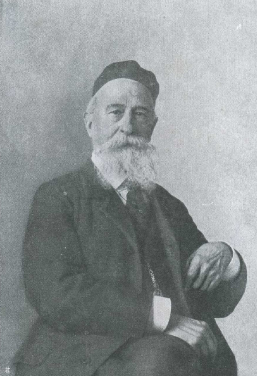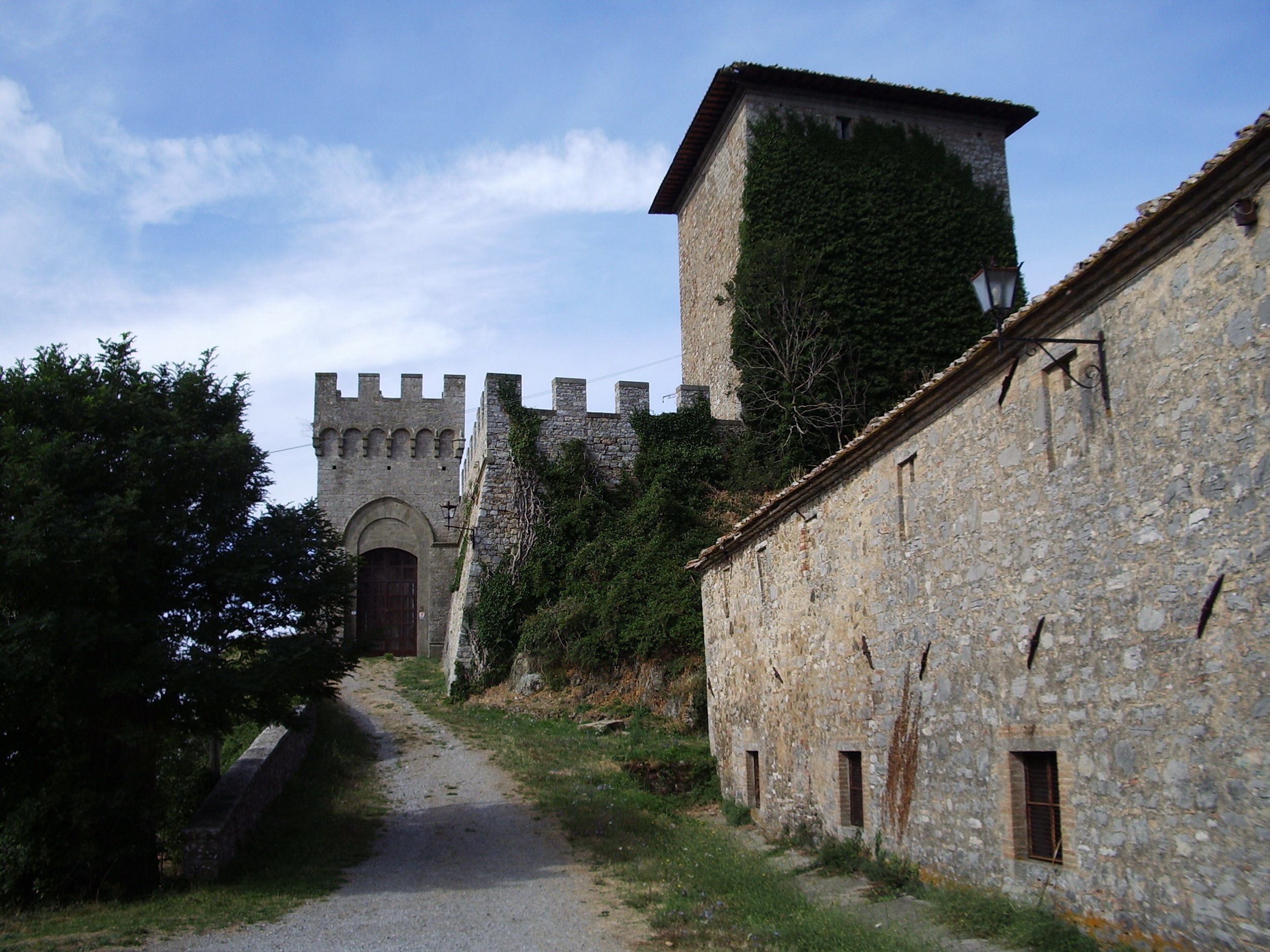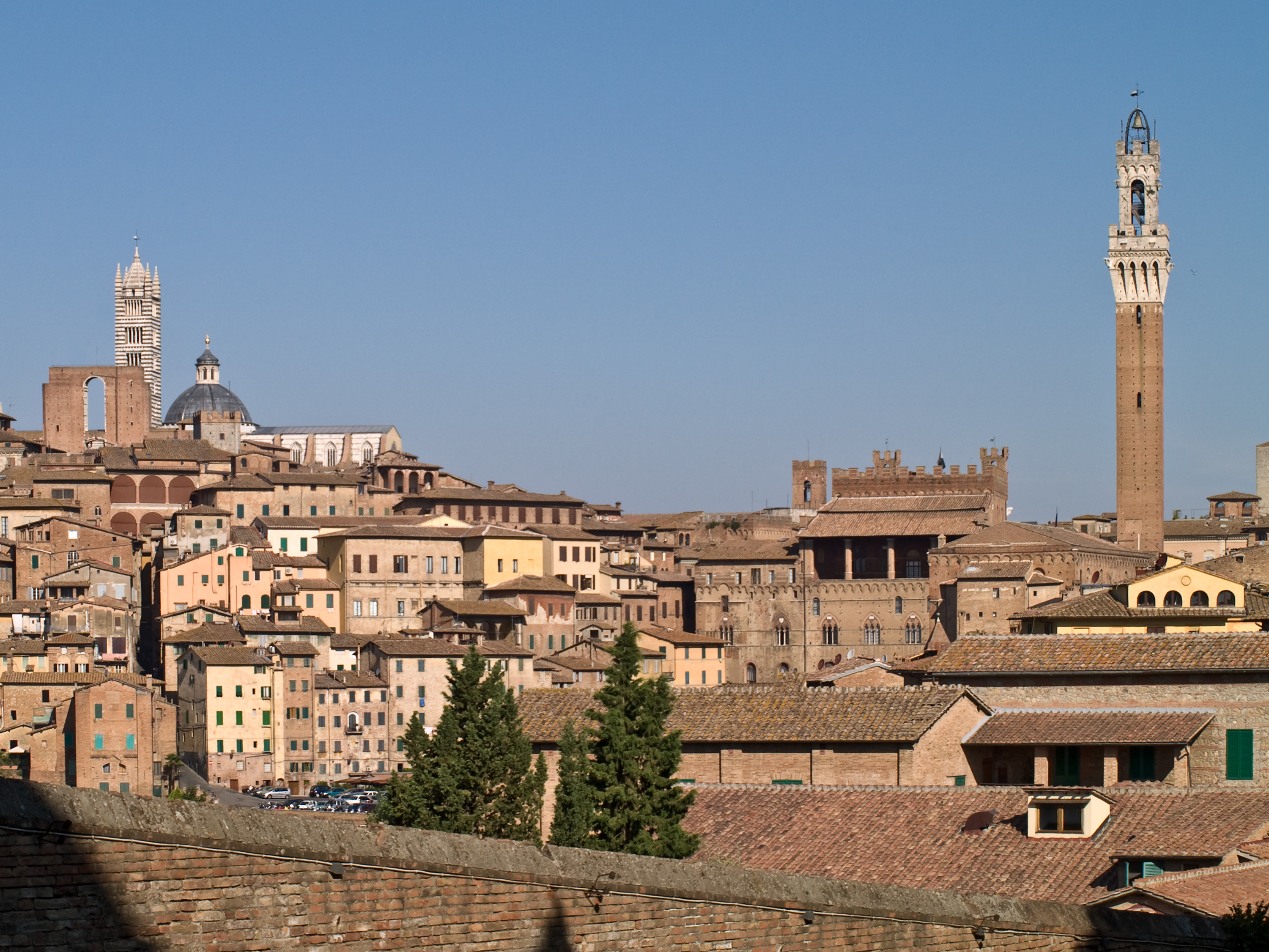|
Palazzo Bichi Ruspoli, Siena
The Palazzo Bichi Ruspoli, or previously Palazzo or Castellare dei Rossi, is an urban palace, located on Via Banchi di Sopra in the present contrada of Civetta, Terzo di Camollia of the city of Siena, region of Tuscany, Italy. History The sober stone palace is just south of the Palazzo Salimbeni and north of the Palazzo Tolomei on the Via Banchi di Sopra. The three story palace with a curved facade was enlarged by Alessandro Bichi in 1520. The palace originally was owned by the Rossi family and housed Charles of Anjou during a stay in Siena. It was built with rusticated limestone blocks in the 14th century around an earlier, 13th century, castle-like block with a tower and peaked ground floor arches. The present rectangular upper windows date to later reconstructions. The present Neoclassic style interiors were commissioned in the 18th century by the Marquis Bichi Ruspoli from the artist and architect Jacopo Franchini. The entrance was designed by Pietro Marchetti. Despite su ... [...More Info...] [...Related Items...] OR: [Wikipedia] [Google] [Baidu] |
Contrade Of Siena
A ''contrada'' (plural: ''contrade'') is generally a district within the Italian countryside. In the city of Siena, the term indicates the 17 urban wards, whose representatives race on horseback in the Palio di Siena, run twice every year in July and August. Each sienese contrada is named after an animal or symbol, with a long history and complicated heraldic and semi-mythological associations. History The ''contrade'' districts were set up in the Middle Ages in order to supply troops to the many military companies that were hired to defend Siena as it fought to preserve its independence from Florence and other nearby city states. With the passage of time, however, the ''contrade'' have lost their administrative and military functions and have become areas of localised patriotism. The communities are held together by their histories, and the emotions and sense of civic pride of the residents. Their roles have broadened so that in the 21st century, every important event – bapt ... [...More Info...] [...Related Items...] OR: [Wikipedia] [Google] [Baidu] |
Alessandro Franchi (painter)
Alessandro Franchi (15 March 1838, in Prato – 29 April 1914, in Siena) was an Italian painter. He worked in a combination of Romantic and Neo-gothic styles, influenced by Purismo. Biography While still very young, he demonstrated his artistic abilities by copying religious works and making sketches of people in ceremonial costumes; worn during processions. His drawing master asked him to reproduce an image of Saint Anthony, made by Fra Filippo Lippi in 1498. On the basis of this, he was able to obtain a scholarship.Brief biography @ the Comune di Prato website. His formal studies began at a local school in Prato, operated by Alessandro Ferrarini (1815-1904). He then became a pupil of |
Gothic Architecture In Siena
Gothic or Gothics may refer to: People and languages *Goths or Gothic people, the ethnonym of a group of East Germanic tribes **Gothic language, an extinct East Germanic language spoken by the Goths **Crimean Gothic, the Gothic language spoken by the Crimean Goths, also extinct **Gothic alphabet, one of the alphabets used to write the Gothic language ** Gothic (Unicode block), a collection of Unicode characters of the Gothic alphabet Art and architecture *Gothic art, a Medieval art movement *Gothic architecture *Gothic Revival architecture (Neo-Gothic) **Carpenter Gothic **Collegiate Gothic **High Victorian Gothic Romanticism *Gothic fiction or Gothic Romanticism, a literary genre Entertainment * ''Gothic'' (film), a 1986 film by Ken Russell * ''Gothic'' (series), a video game series originally developed by Piranha Bytes Game Studios ** ''Gothic'' (video game), a 2001 video game developed by Piranha Bytes Game Studios Modern culture and lifestyle * Goth subculture, a music-cul ... [...More Info...] [...Related Items...] OR: [Wikipedia] [Google] [Baidu] |
Houses Completed In The 14th Century
A house is a single-unit residential building. It may range in complexity from a rudimentary hut to a complex structure of wood, masonry, concrete or other material, outfitted with plumbing, electrical, and heating, ventilation, and air conditioning systems.Schoenauer, Norbert (2000). ''6,000 Years of Housing'' (rev. ed.) (New York: W.W. Norton & Company). Houses use a range of different roofing systems to keep precipitation such as rain from getting into the dwelling space. Houses may have doors or locks to secure the dwelling space and protect its inhabitants and contents from burglars or other trespassers. Most conventional modern houses in Western cultures will contain one or more bedrooms and bathrooms, a kitchen or cooking area, and a living room. A house may have a separate dining room, or the eating area may be integrated into another room. Some large houses in North America have a recreation room. In traditional agriculture-oriented societies, domestic animals such ... [...More Info...] [...Related Items...] OR: [Wikipedia] [Google] [Baidu] |
Houses Completed In The 18th Century
A house is a single-unit residential building. It may range in complexity from a rudimentary hut to a complex structure of wood, masonry, concrete or other material, outfitted with plumbing, electrical, and heating, ventilation, and air conditioning systems.Schoenauer, Norbert (2000). ''6,000 Years of Housing'' (rev. ed.) (New York: W.W. Norton & Company). Houses use a range of different roofing systems to keep precipitation such as rain from getting into the dwelling space. Houses may have doors or lock (security device), locks to secure the dwelling space and protect its inhabitants and contents from burglars or other trespassers. Most conventional modern houses in Western cultures will contain one or more bedrooms and bathrooms, a kitchen or cooking area, and a living room. A house may have a separate dining room, or the eating area may be integrated into another room. Some large houses in North America have a recreation room. In traditional agriculture-oriented societies, Li ... [...More Info...] [...Related Items...] OR: [Wikipedia] [Google] [Baidu] |
Palaces In Siena
A palace is a grand residence, especially a royal residence, or the home of a head of state or some other high-ranking dignitary, such as a bishop or archbishop. The word is derived from the Latin name palātium, for Palatine Hill in Rome which housed the Imperial residences. Most European languages have a version of the term (''palais'', ''palazzo'', ''palacio'', etc.), and many use it for a wider range of buildings than English. In many parts of Europe, the equivalent term is also applied to large private houses in cities, especially of the aristocracy; often the term for a large country house is different. Many historic palaces are now put to other uses such as parliaments, museums, hotels, or office buildings. The word is also sometimes used to describe a lavishly ornate building used for public entertainment or exhibitions such as a movie palace. A palace is distinguished from a castle while the latter clearly is fortified or has the style of a fortification, whereas a ... [...More Info...] [...Related Items...] OR: [Wikipedia] [Google] [Baidu] |
Roccalbegna
Roccalbegna is a ''comune'' (municipality) in the Province of Grosseto in the Italian region Tuscany, located about south of Florence and about east of Grosseto. History Roccalbegna was a fief of the Aldobrandeschi in the Middle Ages; later it was part of the Republic of Siena, until the latter's fall in the hands of the Medici, who sold the town to the County of Santa Fiora. In the 18th century it was returned to the Grand Duchy of Tuscany. ''Frazioni'' The municipality is formed by the municipal seat of Roccalbegna and the villages (''frazioni'') of Cana, Santa Caterina, Triana and Vallerona. Main sights Roccalbegna is home to several notable fortifications, such as the ''Cassero Senese'' (built in the 13th century by the Aldobrandeschi, renovated in the 15th century) and the ''Rocca Aldobrandesca'', located on the hill overlooking the town and the Albegna river (whence the town's name). Outside the town there is the large castle of Triana (known from 760), also owned ... [...More Info...] [...Related Items...] OR: [Wikipedia] [Google] [Baidu] |
Giovanni Bandini
Giovanni may refer to: * Giovanni (name), an Italian male given name and surname * Giovanni (meteorology), a Web interface for users to analyze NASA's gridded data * ''Don Giovanni'', a 1787 opera by Wolfgang Amadeus Mozart, based on the legend of Don Juan * Giovanni (Pokémon), boss of Team Rocket in the fictional world of Pokémon * Giovanni (World of Darkness), a group of vampires in ''Vampire: The Masquerade/World of Darkness'' roleplay and video game * "Giovanni", a song by Band-Maid from the 2021 album ''Unseen World'' * ''Giovanni's Island'', a 2014 Japanese anime drama film * ''Giovanni's Room'', a 1956 novel by James Baldwin * Via Giovanni, places in Rome See also * * *Geovani *Giovanni Battista *San Giovanni (other) *San Giovanni Battista (other) San Giovanni Battista is the Italian translation of Saint John the Baptist. It may also refer to: Italian churches * San Giovanni Battista, Highway A11, a church in Florence, Italy * San Giovanni Battista, ... [...More Info...] [...Related Items...] OR: [Wikipedia] [Google] [Baidu] |
Cesare Maffei
Cesare Maffei (born 1805) was an Italian painter of the Neoclassical period, active in Tuscany it, Toscano (man) it, Toscana (woman) , population_note = , population_blank1_title = , population_blank1 = , demographics_type1 = Citizenship , demographics1_footnotes = , demographics1_title1 = Italian , demogra .... Biography He was the son of an ornamental painter, and his brother Alessandro, was a decorative painter. Cesare studied at the Accademia di Belle Arti di Siena, under Giuseppe Collignon and Francesco Mazzuoli. Between 1836 and 1838, he helped paint frescoes of angel musicians for the church of San Giacomo, Siena. He also painted a cycle of frescoes for the Palazzo Piccolomini-Clementini. He was a scenographer and decorator for the Teatro Pagliano in Florence, which would become the Teatro Verdi, Florence, Teatro Verdi. In 1854, he decorated the tribune of the church of San Regolo in Montaione, depicting the ''Virgin in Glory with Sain ... [...More Info...] [...Related Items...] OR: [Wikipedia] [Google] [Baidu] |
Pietro Marchetti
Pietro Marchetti or Marchettis (1589 – 16 April 1673) was an Italian physician, anatomist and surgeon. According to the British historian of medicine Edward Withington, Marchetti was one the most important Italian surgeons of the seventeenth century. Biography Pietro Marchetti was professor of anatomy at Padua, where he was born, and where he continued to teach from 1652 until 1669, when he was allowed to resign his chair to his son Antonio. In 1661, he also obtained the appointment to the first professorship of surgery, which he held along with that of anatomy. Marchetti had an excellent knowledge of anatomy, and made important contributions to liver surgery, orthopedic surgery, neurosurgery and the treatment of gunshot wounds. For his merits, he was made knight of the Order of Saint Mark. Marchetti became famous both in Italy and abroad. Francis Willughby and John Ray attended his lectures during their stay in Padua in 1663-64. At the age of 80, he retired altogether ... [...More Info...] [...Related Items...] OR: [Wikipedia] [Google] [Baidu] |
Siena
Siena ( , ; lat, Sena Iulia) is a city in Tuscany, Italy. It is the capital of the province of Siena. The city is historically linked to commercial and banking activities, having been a major banking center until the 13th and 14th centuries. Siena is also home to the oldest bank in the world, the Monte dei Paschi bank, which has been operating continuously since 1472. Several significant Renaissance painters worked and were born in Siena, among them Duccio, Ambrogio Lorenzetti, Simone Martini and Sassetta, and influenced the course of Italian and European art. The University of Siena, originally called ''Studium Senese'', was founded in 1240, making it one of the oldest universities in continuous operation in the world. Siena was one of the most important cities in medieval Europe, and its historic centre is a UNESCO World Heritage Site. From January until the end of September of 2021 it had about 217,000 arrivals, with the largest numbers of foreign visitors com ... [...More Info...] [...Related Items...] OR: [Wikipedia] [Google] [Baidu] |
Jacopo Franchini
Jacopo (also Iacopo) is a masculine Italian given name, derivant from Latin ''Iacōbus''. It is an Italian variant of Giacomo. * Jacopo Aconcio (), Italian religious reformer * Jacopo Bassano (1592), Italian painter * Iacopo Barsotti (1921–1987), Italian mathematician * Jacopo da Bologna (), Italian composer * Jacopo Comin (1518–1594), Italian painter otherwise known as Tintoretto * Jacopo Carucci (1494–1557), Italian painter otherwise known as Pontormo * Jacopo Corsi (1561–1602), Italian composer * Jacopo da Leona (died 1277), Italian poet * Jacopo Peri (1561–1633), Italian composer * Jacopo della Quercia (1438), Italian sculptor * Jacopo Riccati (1676–1754), Italian mathematician * Jacopo Sadoleto (1477–1547), Italian Catholic cardinal * Jacopo M. (1989), Italian Communicator, upholder of the European Commission Fictional characters: * Jacopo, a key character in the 2002 film version of ''The Count of Monte Cristo'' (and a minor character in the book). * Jacopo ... [...More Info...] [...Related Items...] OR: [Wikipedia] [Google] [Baidu] |





